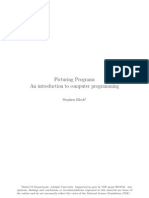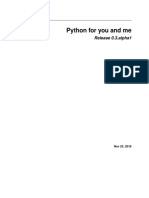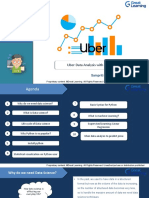0 ratings0% found this document useful (0 votes)
64 viewsPython Material
Python study material by techforge
Uploaded by
Hari PrasadCopyright
© © All Rights Reserved
Available Formats
Download as PDF or read online on Scribd
0 ratings0% found this document useful (0 votes)
64 viewsPython Material
Python study material by techforge
Uploaded by
Hari PrasadCopyright
© © All Rights Reserved
Available Formats
Download as PDF or read online on Scribd
You are on page 1/ 13
TECHFORGE
Study Materia] sam
IPYTHON
Explorer's Guide
@
vix TECHFORG
TESHEORSE
The Python Explorer's Guide by Techforge Academy
Dear Techforge Academy Interns,
Welcome to the Techforge Academy Internship Program! We are thrilled to have you
on board and embark on this exciting journey together. The next few weeks promise
to be a period of tremendous learning, growth, and hands-on experience in the
dynamic world of technology.
About Techforge Academy: Techforge Academy is more than just an educational
institution; it's a community of passionate learners and skilled professionals
dedicated to fostering excellence in technology. Our mission is to empower
individuals like you with the knowledge and skills needed to thrive in the ever-
evolving tech landscape.
Internship Overview: During this internship, you will delve into various modules
covering essential aspects of programming, software development, and industry best
practices. From mastering the fundamentals of Python to exploring advanced topics
like web development and asynchronous programming, you will gain a
comprehensive understanding of the tools and techniques that drive innovation.
What to Expect:
Engaging Modules: Our carefully crafted modules aim to provide you with a solid
foundation in Python and its applications.
Hands-on Experience: You'll have the opportunity to apply your knowledge through
practical examples and real-world projects.
Supportive Environment: Our team of experienced mentors and instructors is here
to guide you every step of the way.
Python Training Material Outline:
Module 1: Introduction to Python
Overview of Python
Installation of Python
Python Interpreter and Interactive Mode
Writing and Running Python Scripts
Module 2: Basic Python Syntax
Variables and Data Types
Operators and Expressions
Print Statement
Basic Input/Output
Module 3: Control Flow
Conditional Statements (if, elif, else)
Loops (for, while)
Break and Continue Statements
Exception Handling (try, except)
Module 4: Data Structures
Lists, Tuples, and Sets
Dictionaries
Working with Collections (slicing, indexing, etc)
Module 5: Functions
Defining Functions
Parameters and Return Values
Scope and Lifetime of Variables
Lambda Functions
Module 6: File Handling
Reading and Writing to Files
Working with Text and Binary Files
Using with Statement
Module 7: Object-Oriented Programming (OOP)
Classes and Objects
Inheritance and Polymorphism
Encapsulation and Abstraction
Class Methods and Instance Methods
Module 8: Modules and Packages
Creating Modules
Importing Modules and Packages
Exploring Python Standard Library
Module 9: Working with APIs
Making HTTP Requests (using requests module)
Handling JSON Data
Example: Fetching data from an API
Module 10: Introduction to Libraries and Frameworks
Overview of popular libraries (NumPy, Pandas, Matplotlib)
Introduction to Flask (Web framework)
Module 11: Best Practices and Coding Standards
PEP 8 - Python Enhancement Proposals
Code Readability and Style Guidelines
Writing Clean and Maintainable Code
Module 12: Project Workshops
Small projects to reinforce learning
Encourage participants to build a simple application
Module 13: Advanced Topics (Optional)
Decorators and Generators
Concurrency and Parallelism
Introduction to Asynchronous Programming (async/await)
Module 14: Testing in Python
Unit Testing with unittest or pytest
Writing Test Cases
Test Automation
Module 15: Deployment and Packaging
Creating Executables with pyinstaller or cx_Freeze
Packaging Python Projects
Module 1: Introduction to Python
Overview of Python
Python is a high-level, interpreted programming language known for its simplicity
and readability.
Developed by Guido van Rossum and first released in 1991.
Installation of Python
Download Python from python.org and follow installation instructions.
Python Interpreter and Interactive Mode
The Python interpreter is a command-line tool for running Python code interactively.
To start the interpreter, open a terminal or command prompt and type python or
python3,
Interactive mode allows executing Python statements one at a time.
Writing and Running Python Scripts
Python scripts are plain text files with a .py extension
Use a text editor (e.g, VS Code, Atom, or IDLE) to write scripts.
Run a script by executing python script_name.py in the terminal.
Sample Program: Hello World
pythonCopy code
# hello_world.py print(*Hello, World!")
Module 2: Basic Python Syntax
Variables and Data Types
Variables are used to store data. No need to declare the type explicitly.
Common data types: int, float, str, bool
Operators and Expressions
Arithmetic operators:+, -, *, /, //, &
Comparison operators: ==, !=, <, >, <=, >=
Logical operators: and, or, not
Print Statement
The print () function is used to output data to the console.
Basic Input/Output
input () function is used to take user input.
Sample Program: Simple Calculator
pythonCopy code
# simple_calculator.py num! = float(input("Enter the first number: ")) num2 = float(input("Enter the second
number: ")) sum_result = num] + num? print("Sum:", sum_result)
Module 3: Control Flow
Conditional Statements (if, elif, else)
ig statements are used for decision-making.
e1i¢ is short for "else if.”
else is executed if no ag or e1i¢ condition is true.
Loops (for, while)
for loop iterates over a sequence (list, tuple, string, etc).
white loop repeats a block of code as long as a condition is true.
Break and Continue Statements
break exits the loop prematurely.
continue skips the rest of the loop's code and goes to the next iteration.
Exception Handling (try, except)
try block contains the code to be executed.
except block handles exceptions if they occur.
Sample Program: Grade Calculator
pythonCopy code
grade ='A’ elif score >= 80:
gtade)
sore = float(input y
70: grade ='C' else: grade
Module 4: Data Structures
Lists, Tuples, and Sets
Lists are mutable, ordered sequences.
Tuples are immutable, ordered sequences
Sets are unordered collections of unique elements.
Dictionaries
Dictionaries are collections of key-value pairs.
Working with Collections
Indexing, slicing, and iterating through elements.
Sample Program: Shopping List
pythonCopy code
# shopping_listpy shopping_list = apple, "banana, ‘carrot, ‘orange’ prin(*Original Shopping List:
shopping_list)# Add an item shopping_lstappend( grapes) print"Updated Shopping List", shopping_list) #
Remove an item item_to remove = input("Enter an item to remove: *) if item to remove in shopping list:
shopping_fistremovelitem_to_ remove) print("Updated Shopping List", shopping_list) else; printTtem not
found in the list.")
Module 5: Functions
Defining Functions
Functions are blocks of reusable code.
Defined using the det keyword.
Parameters and Return Values
Parameters are values passed to a function.
Return statement exits the function and can return a value.
Scope and Lifetime of Variables
Variables have a scope, determining where they can be accessed.
Lambda Functions
Anonymous functions defined using the lambda keyword,
Sample Program: Area of a Circle
pythonCopy code
# area_of circle.py import math def calculate_area(radius): return math.pi * radius**2 radius
float(input("Enter the radius of the circle: ")) area = calculate_area(radius) print("The area of the circle is:",
area)
Module 6: File Handling
Reading and Writing to Files
Use the open () function to open a file.
read(), readline (), and readlines() methods for reading.
write() method for writing,
Working with Text and Binary Files
‘x! for reading, 'w' for writing, ‘a’ for appending,
‘bt mode for binary files.
Using with Statement
The with statement simplifies file management.
Sample Program: File Reader
pythonCopy code
# file_reader.py filename = input("Enter the filename: ") try: with open({ilename, 'r’) as file: content = fileread()
print("File Content:\n", content) except FileNotFoundError: print(?*File {filename} not found.) except
Exception as e: print("An error occurred:", €)
Module 7: Object-Oriented Programming (OOP)
Classes and Objects
Classes define objects and their behavior.
Objects are instances of classes.
Inheritance and Polymorphism
Inheritance allows a class to inherit properties and methods from another.
Polymorphism allows objects to be treated as instances of their parent class.
Encapsulation and Abstraction
Encapsulation restricts access to certain components.
Abstraction hides complex implementations.
Class Methods and Instance Methods
Class methods are bound to the class.
Instance methods are bound to instances of the class.
Sample Program: Person Class
pythonCopy code
# person_classpy class Person: def init__(self, name, age): sefiname = name selfage = age def
0: yield nn = 1 # Using the generator for num in
countdown(5): print(num)
Module 14: Testing in Python
Unit Testing with unittest or pytest
Write tests to ensure the correctness of code.
unittest and pytest are popular testing frameworks.
Writing Test Cases
Test cases check specific aspects of the code.
Test Automation
Automate test execution to ensure code quality.
Sample Program: Unit Testing
pythonCopy code
# test_calculator.py import unittest from simple_caleulator import add class TestCaleulator(unit
def test_adal self): selfassertE qual(add{2, 3), 5) selfassertEqual(ad(-1, 1),0) if _name_
unitest.main()
st.TestCase):
Module 15: Deployment and Packaging
Creating Executables with pyinstaller or cx_Freeze
Convert Python scripts into standalone executables.
pyinstaller and cx_Freeze are tools for this purpose.
Packaging Python Projects
Use setup. py and pip for project packaging.
Distribute projects using PyPI (Python Package Index).
Sample Progra
: Flask Web Application
pythonCopy code
# app.py from flask import Flask app = Flask(_name_) @app.coute(7) def home(): return ‘Helo, Flask! if
__name_—='__main_': app.run(debug=True)
Conclusion and Best Wishes:
‘As you embark on this internship journey, remember that learning is a continuous
process, and each challenge is an opportunity to grow. We believe in your potential
‘to make a meaningful impact in the tech industry, and we are excited to witness your
progress.
Wishing you:
+ Curiosity: Stay curious and never stop asking questions. It's the key to unlocking
new possibilities.
+ Resilience: Challenges will come, but so will solutions. Embrace setbacks as
opportunities to learn and improve.
+ Collaboration: Technology thrives on collaboration. Build connections, share ideas,
and work together to achieve greatness.
+ Innovation: Be bold in your ideas and creative in your solutions. The tech world is
ever-changing, and innovation is your driving force.
Once again, welcome to Techforge Academy! May this internship be a stepping
stone to a future filled with success, knowledge, and innovation.
Mice tances
A
TECHFORGE
we ore here 10 make it
First floor, Gandhi Road, 2C, Johnsonpet Rd,
Hasthampatti, Salem, Tamil Nadu 636007
+91 96008 61277 : www.techforge.in
You might also like
- Python Generators: How To Create A Generator in Python?No ratings yetPython Generators: How To Create A Generator in Python?8 pages
- 8 Best Python Cheat Sheets For Beginners and Intermediate Learners100% (1)8 Best Python Cheat Sheets For Beginners and Intermediate Learners13 pages
- The Python Workbook: A Brief Introduction with Exercises and Solutions 2nd Edition Ben Stephenson all chapter instant download100% (1)The Python Workbook: A Brief Introduction with Exercises and Solutions 2nd Edition Ben Stephenson all chapter instant download49 pages
- Gujarat Technological University: Semester - V Subject Name: Python ProgrammingNo ratings yetGujarat Technological University: Semester - V Subject Name: Python Programming4 pages
- International Indian School, Riyadh WORKSHEET (2020-2021) Grade - Xii - Informatics Practices - Second TermNo ratings yetInternational Indian School, Riyadh WORKSHEET (2020-2021) Grade - Xii - Informatics Practices - Second Term9 pages
- Top 100 Python Interview Questions & Answers For 2021 - EdurekaNo ratings yetTop 100 Python Interview Questions & Answers For 2021 - Edureka24 pages
- Introduction To Python Programming: Dr. R. Rajeswara Rao Professor & Head Dept. of CSE Jntuk-Ucev VizianagaramNo ratings yetIntroduction To Python Programming: Dr. R. Rajeswara Rao Professor & Head Dept. of CSE Jntuk-Ucev Vizianagaram27 pages
- Machine Learning in Python Main Developments and T100% (1)Machine Learning in Python Main Developments and T44 pages
- CSE 1001 (Python) Faculty Name: Dr. AMIT Kumar TyagiNo ratings yetCSE 1001 (Python) Faculty Name: Dr. AMIT Kumar Tyagi16 pages
- Python 3 Beginner's Reference Cheat Sheet: by Via100% (1)Python 3 Beginner's Reference Cheat Sheet: by Via1 page
- Coffee Break Python Slicing - Christian MayerNo ratings yetCoffee Break Python Slicing - Christian Mayer89 pages
- Web Development Internship Project Report Sample0% (1)Web Development Internship Project Report Sample6 pages
- Python Generators: How To Create A Generator in Python?Python Generators: How To Create A Generator in Python?
- 8 Best Python Cheat Sheets For Beginners and Intermediate Learners8 Best Python Cheat Sheets For Beginners and Intermediate Learners
- The Python Workbook: A Brief Introduction with Exercises and Solutions 2nd Edition Ben Stephenson all chapter instant downloadThe Python Workbook: A Brief Introduction with Exercises and Solutions 2nd Edition Ben Stephenson all chapter instant download
- Gujarat Technological University: Semester - V Subject Name: Python ProgrammingGujarat Technological University: Semester - V Subject Name: Python Programming
- International Indian School, Riyadh WORKSHEET (2020-2021) Grade - Xii - Informatics Practices - Second TermInternational Indian School, Riyadh WORKSHEET (2020-2021) Grade - Xii - Informatics Practices - Second Term
- Top 100 Python Interview Questions & Answers For 2021 - EdurekaTop 100 Python Interview Questions & Answers For 2021 - Edureka
- Introduction To Python Programming: Dr. R. Rajeswara Rao Professor & Head Dept. of CSE Jntuk-Ucev VizianagaramIntroduction To Python Programming: Dr. R. Rajeswara Rao Professor & Head Dept. of CSE Jntuk-Ucev Vizianagaram
- Machine Learning in Python Main Developments and TMachine Learning in Python Main Developments and T
- CSE 1001 (Python) Faculty Name: Dr. AMIT Kumar TyagiCSE 1001 (Python) Faculty Name: Dr. AMIT Kumar Tyagi































































